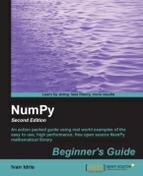First, let's set up some arrays:
In: a = arange(9).reshape(3,3)
In: a
Out:
array([[0, 1, 2],
[3, 4, 5],
[6, 7, 8]])
In: b = 2 * a
In: b
Out:
array([[ 0, 2, 4],
[ 6, 8, 10],
[12, 14, 16]])- Horizontal stacking: Starting with horizontal stacking, we will form a tuple of
ndarraysand give it to thehstackfunction. This is shown as follows:In: hstack((a, b)) Out: array([[ 0, 1, 2, 0, 2, 4], [ 3, 4, 5, 6, 8, 10], [ 6, 7, 8, 12, 14, 16]])We can achieve the same with the
concatenatefunction, which is shown as follows:In: concatenate((a, b), axis=1) Out: array([[ 0, 1, 2, 0, 2, 4], [ 3, 4, 5, 6, 8, 10], [ 6, 7, 8, 12, 14, 16]])
- Vertical stacking: With vertical stacking, again, a tuple is formed. This time, it is given to the
vstackfunction. This can be seen as follows:In: vstack((a, b)) Out: array([[ 0, 1, 2], [ 3, 4, 5], [ 6, 7, 8], [ 0, 2, 4], [ 6, 8, 10], [12, 14, 16]])The
concatenatefunction produces the same result with the axis set to0. This is the default value for the axis argument.In: concatenate((a, b), axis=0) Out: array([[ 0, 1, 2], [ 3, 4, 5], [ 6, 7, 8], [ 0, 2, 4], [ 6, 8, 10], [12, 14, 16]])
- Depth stacking: Additionally, there is the depth-wise stacking using
dstackand a tuple, of course. This means stacking of a list of arrays along the third axis (depth). For instance, we could stack 2D arrays of image data on top of each other.In: dstack((a, b)) Out: array([[[ 0, 0], [ 1, 2], [ 2, 4]], [[ 3, 6], [ 4, 8], [ 5, 10]], [[ 6, 12], [ 7, 14], [ 8, 16]]]) - Column stacking: The
column_stackfunction stacks 1D arrays column-wise. It's shown as follows:In: oned = arange(2) In: oned Out: array([0, 1]) In: twice_oned = 2 * oned In: twice_oned Out: array([0, 2]) In: column_stack((oned, twice_oned)) Out: array([[0, 0], [1, 2]])2D arrays are stacked the way
hstackstacks them:In: column_stack((a, b)) Out: array([[ 0, 1, 2, 0, 2, 4], [ 3, 4, 5, 6, 8, 10], [ 6, 7, 8, 12, 14, 16]]) In: column_stack((a, b)) == hstack((a, b)) Out: array([[ True, True, True, True, True, True], [ True, True, True, True, True, True], [ True, True, True, True, True, True]], dtype=bool)Yes, you guessed it right! We compared two arrays with the
==operator. Isn't it beautiful? - Row stacking: NumPy, of course, also has a function that does row-wise stacking. It is called
row_stackand, for 1D arrays, it just stacks the arrays in rows into a 2D array.In: row_stack((oned, twice_oned)) Out: array([[0, 1], [0, 2]])The
row_stackfunction results for 2D arrays are equal to, yes, exactly, thevstackfunction results.In: row_stack((a, b)) Out: array([[ 0, 1, 2], [ 3, 4, 5], [ 6, 7, 8], [ 0, 2, 4], [ 6, 8, 10], [12, 14, 16]]) In: row_stack((a,b)) == vstack((a, b)) Out: array([[ True, True, True], [ True, True, True], [ True, True, True], [ True, True, True], [ True, True, True], [ True, True, True]], dtype=bool)
We stacked arrays horizontally, depth-wise, and vertically. We used the vstack, dstack, hstack, column_stack, row_stack, and concatenate functions.
..................Content has been hidden....................
You can't read the all page of ebook, please click here login for view all page.
